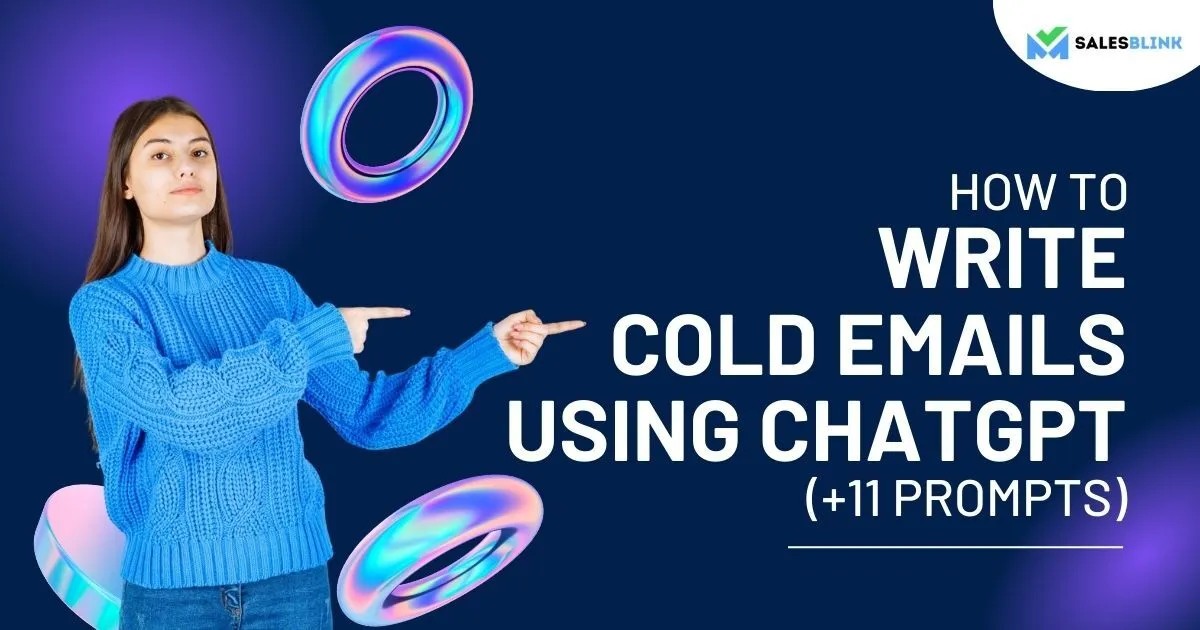How To Write Cold Emails Using ChatGPT (+11 Prompts)
Cold emailing continues to be an effective way to reach out to prospects. In fact, research shows that cold emails can have an impressive open rate of 15-25% when done correctly. However, writing that perfect email that captures attention and sparks an interest can be challenging. But don’t worry because you can write cold emails using ChatGPT!
In this post, we’ll explore how to leverage the power of ChatGPT, a cutting-edge AI language model, to write engaging and persuasive cold emails. We’ll walk you through 11 prompts designed to assist you in creating emails that not only stand out in crowded inboxes but also resonate with your recipients. From intriguing subject lines to compelling calls-to-action, ChatGPT can be your secret weapon for successful cold email campaigns.
So, let’s dive in and understand how to write cold emails using ChatGPT.
Table of Contents
What Is ChatGPT?
ChatGPT is a stunning artificial intelligence language model created by OpenAI. It’s based on GPT-4 architecture, which helps it sound more like a human having a conversation. Not only can it understand context, but it can also provide helpful info on a whole bunch of topics and tasks – whether it’s answering questions or creating content!
Now, it’s not perfect (no AI is), but despite its limitations, ChatGPT has made a big impact in the world of natural language processing and understanding. It’s really pushing the boundaries of what AI can do!
Why Is ChatGPT Important For Cold Email Campaigns?
ChatGPT is vital in improving email campaigns by generating persuasive and engaging content tailored to specific audience segments. It maintains a consistent brand voice, ensuring all communications align with your brand identity. In addition, its automation capabilities streamline the content creation process, saving time and resources for your team.
The AI chatbot aids in A/B testing by generating multiple email variations, enabling you to identify the best-performing content. This data-driven approach refines your email campaigns and enhances their overall performance, leading to higher engagement and conversion rates for your business.
What Are The Benefits And Limitations Of ChatGPT?
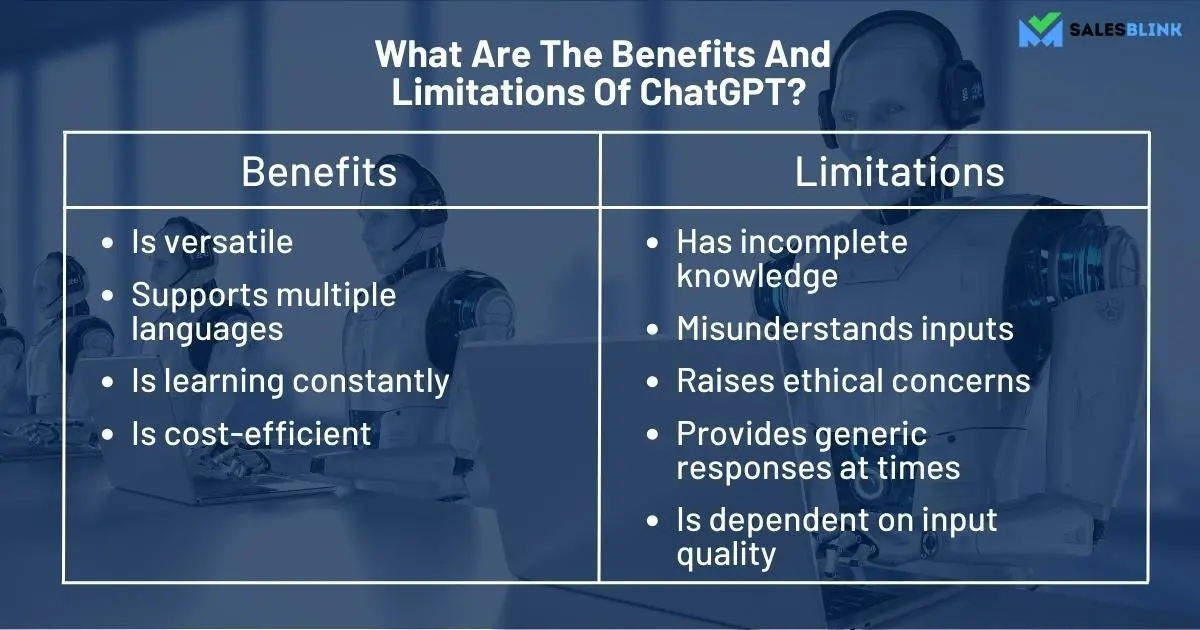
ChatGPT, a cutting-edge language model, offers various benefits and also faces certain limitations. We’ll take a look at both.
Benefits:
- Is versatile: You can use ChatGPT in diverse applications such as customer support, content generation, education, and much more.
- Supports multiple languages: It can understand and generate text in multiple languages, facilitating global accessibility.
- Is learning constantly: It is designed to improve over time through regular updates and user feedback, leading to better performance.
- Is cost-efficient: ChatGPT can potentially reduce labor costs and streamline operations in industries that depend heavily on human communication.
Limitations:
- Has incomplete knowledge: ChatGPT’s knowledge base is limited to the training data (the cut-off is September 2021), and it may not be aware of recent developments or specific information.
- Misunderstands inputs: It may occasionally fail to grasp the user’s intent or provide inappropriate responses.
- Raises ethical concerns: There is a risk of generating biased or offensive content, though developers actively work on minimizing these issues.
- Provides generic responses at times: ChatGPT may sometimes generate plausible but vague responses, lacking depth or specificity.
- Is dependent on input quality: The quality of the generated response depends on the clarity and context provided by the user, which may lead to unsatisfactory results if not adequately supplied.
How Does ChatGPT Work?
Here’s a simple explanation of how ChatGPT functions:
Training
ChatGPT’s training involves using a massive dataset containing parts of the internet, including articles, books, and websites. It is trained with patterns, grammar, facts, and reasoning skills from this data.
It doesn’t just memorize; it also learns how to generate new sentences by understanding the context and relationships between words.
Tokenization
When you send a message to ChatGPT, it breaks down your text into smaller parts called tokens. These tokens can be words or parts of words, and they help the model understand the context and meaning of your message.
Prediction
ChatGPT then tries to predict the best possible response to your message. It estimates the likelihood of different words or tokens appearing next in the sequence. The model generates multiple possible responses and scores them based on what it learns during training.
Decoding
Once ChatGPT has generated several possible responses, it selects the most suitable one by decoding the tokens back into words. This process ensures that the final response makes sense in the conversation’s context.
Interaction
The AI then sends the generated response back to you. You can continue the conversation, and the process repeats with each new message.
In short, ChatGPT works by learning from a vast amount of text data, breaking down your message into tokens, predicting the most likely response, decoding it into human-readable text, and then sending that response back to you.
How To Write Cold Emails Using ChatGPT?
You must create the right prompts to use ChatGPT effectively for writing cold emails. We’ll see how you can go about email copywriting with the AI tool.
Here’s how to write cold emails using ChatGPT,
Understand the Target Audience’s Pain Points
Understanding the target audience’s pain points is essential for sales professionals as it enables them to position their products or services as ideal solutions, increasing the likelihood of closing deals.
By identifying the pain points, sales representatives can write personalized messages that resonate with prospects’ concerns and emotions, demonstrating empathy and enhancing trust between both parties.
Recognizing and addressing pain points also provides a unique selling proposition, allowing sales professionals to differentiate themselves and their offerings from competitors who may not be catering to these specific issues.
Addressing pain points creates a better customer experience, fostering long-term relationships and leading to repeat business, referrals, and positive testimonials.
Furthermore, understanding the most significant pain points allows sales professionals to prioritize leads based on the potential impact of their product or service. This helps them focus on prospects most likely to convert and generate higher revenue, optimizing their sales efforts and overall success.
Here’s how your ChatGPT prompt to know the pain points of an ideal customer can look like.
What are the common pain points of sales reps when they try to generate leads and reach out to them?
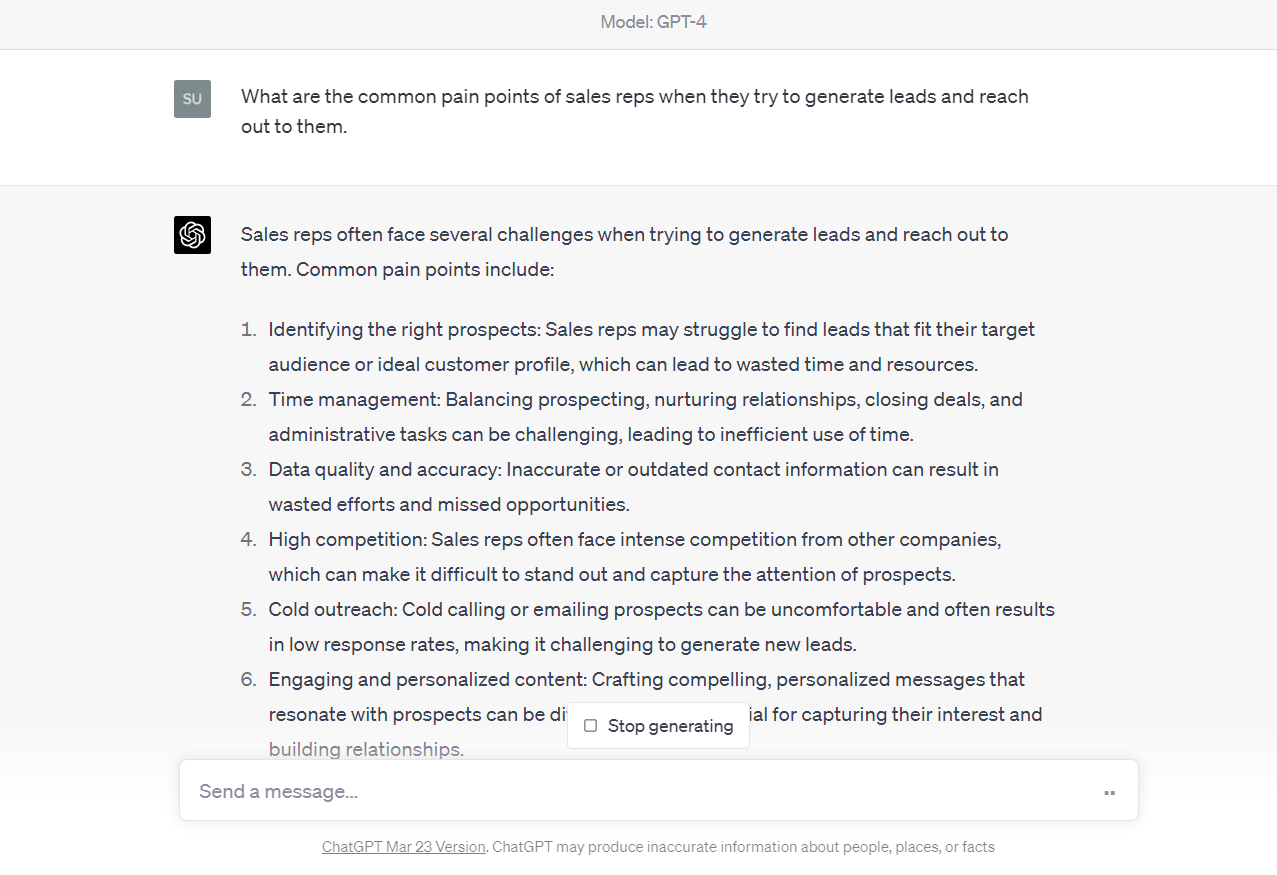
Based on these pain points, you can work on creating an approach.
Write The First Draft Of Your Cold Email
Writing the first draft of your cold email is super important for a few reasons.
First, it helps you get a clear idea of what you want to say and your main goal. Plus, it allows you to make the email content feel more personal, which can make a difference when you’re trying to connect with someone new.
The first draft also helps you organize your thoughts and spot any gaps or weak points in your message, allowing you to fix them up before hitting send.
But remember, the first draft is just the beginning! It’s all about testing and refining your message to make it the best it can be. As you work through revisions, you’ll improve your email and build confidence in your writing and communication skills. So don’t be afraid to dive in and start on that first draft – it’s the first step towards a successful cold email outreach.
Here’s how ChatGPT can help you,
Write a cold email for my SaaS company that helps sales teams automate the sales process. Keep it casual and at most 100 words long.
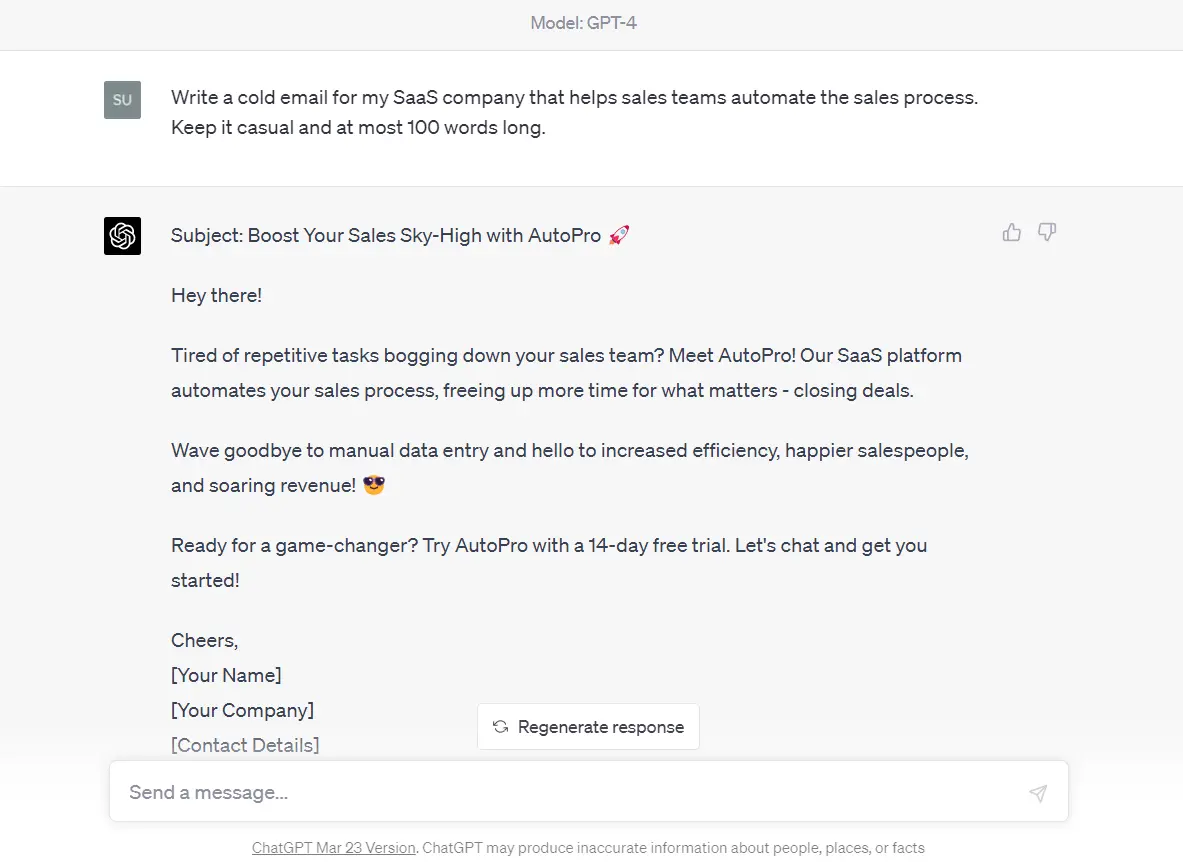
Here’s another one for you,
Write a cold email for my accounting company that offers a solution to help accounts teams with computing. Keep it concise and at most 100 words in length. Also, personalize it.
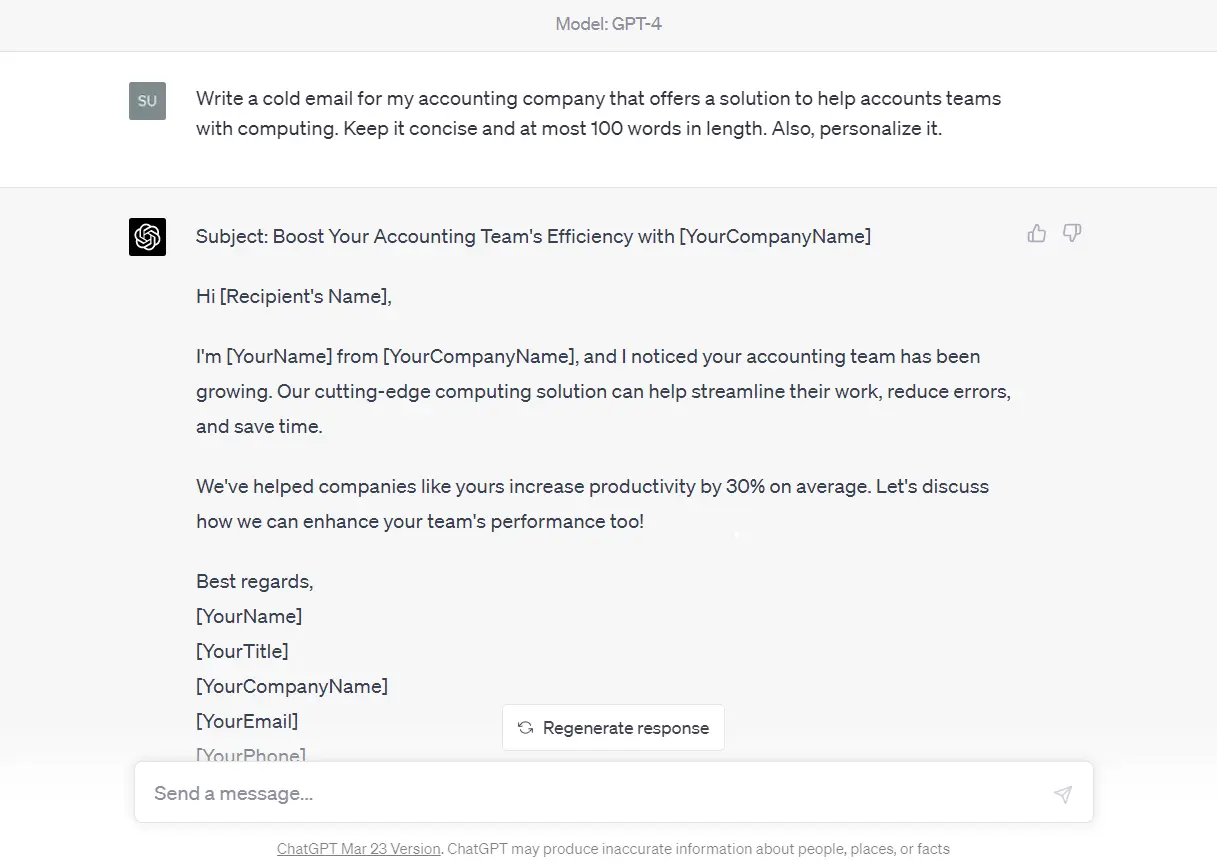
You can make the necessary changes in the output and use the draft for your cold email sequence.
Generate Follow-up Emails
Writing follow-up emails in sales is super important because it helps to keep the conversation going with potential clients. Sometimes people get busy or simply forget to respond, and a friendly nudge can remind them of your offer.
Plus, follow-ups show that you’re genuinely interested in helping them out and are committed to building a relationship. It’s all about staying connected and increasing your chances of closing the deal. Pretty essential, right?
Here’s the second ChatGPT prompt that follows the above to help you write follow-up emails.
Write a follow-up email for the cold email above for my SaaS company to reach out to sales teams looking for automation.
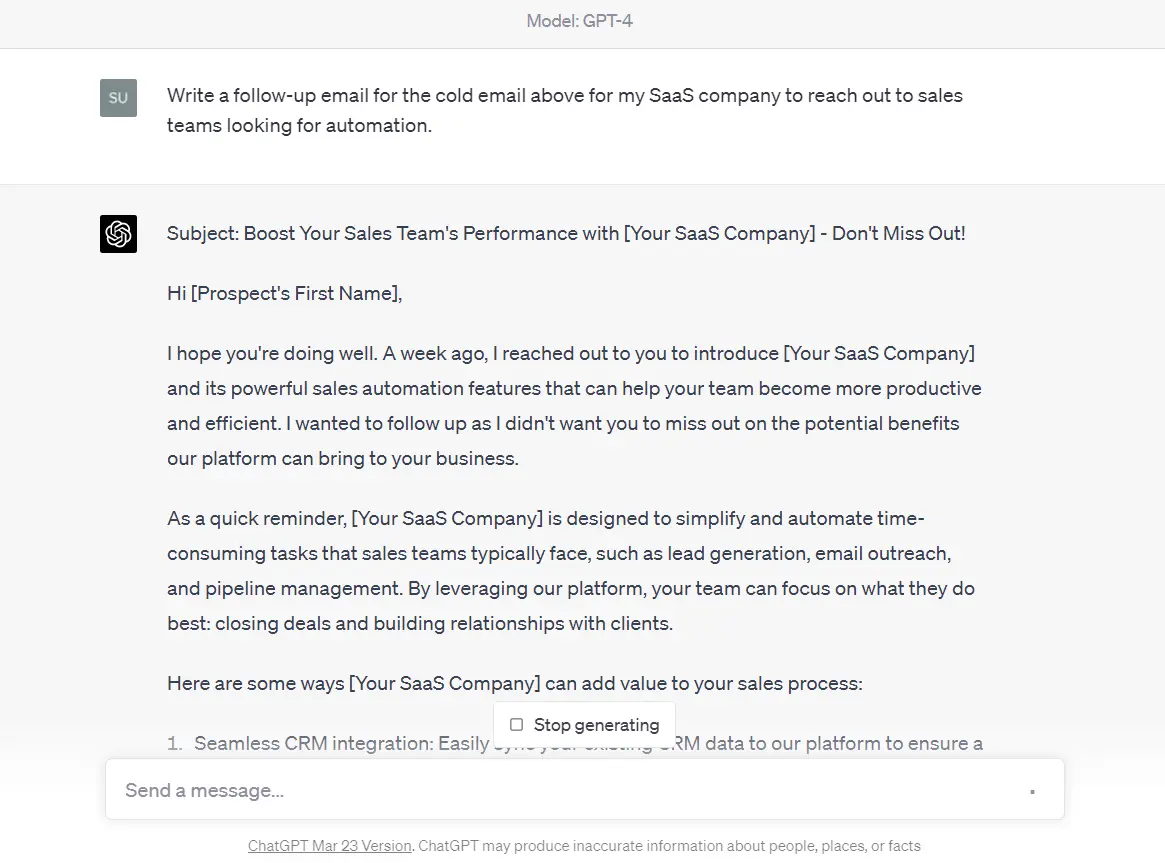
Ask to generate Catchy Email Subject Lines
Writing a catchy subject line for your B2B cold emails is all about grabbing the recipient’s attention and enticing them to open the message. The key is to keep it short, relevant, and personalized.
Start by researching your target audience to understand their pain points, interests, or industry trends. Then, using this information, create a subject line that addresses a specific need or appeals to their curiosity.
For example, instead of a generic subject like “Grow Your Business,” try something like “Boost Your Sales in 30 Days: Exclusive Insights for [Industry].” This way, your prospect feels like the email is tailored to them and their needs, making them more likely to engage with your content.
Another tactic to make your subject lines stand out is to use action verbs and a sense of urgency. This helps convey the value of your offering and prompts the recipient to act quickly.
Always ensure your subject line accurately reflects the content of your email. Being misleading might lead to a higher open rate, but it won’t do you any favors in building trust and credibility with your prospects. And, of course, test different subject lines to find out what works best for your target audience!
ChatGPT can help you write striking subject lines for your cold emails. Here’s a prompt that works well (it is in continuation with the previous prompts)
Write 10 different subject lines for the above cold email.
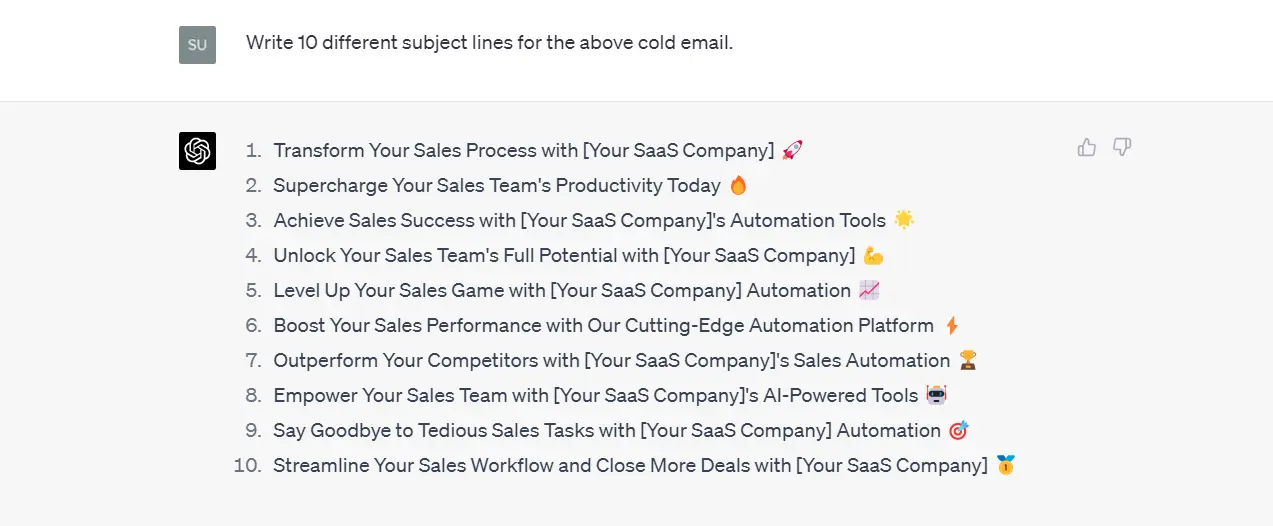
You can use the output as it is or make changes to it. Whatever it is, it does save the time you spend writing subject lines on your own.
Brainstorm CTA Ideas
CTAs in cold sales emails should be clear, concise, and compelling to guide recipients toward the desired outcome and highlight the value you’re offering. In addition, they should make it easy for the reader to take the next step, such as booking a meeting or signing up for a trial.
A strong CTA uses persuasive language and often creates a sense of urgency, encouraging the reader to act quickly. Additionally, CTAs impact the success rate of your email campaign.
Attention-grabbing CTAs help increase click-through rates, allowing you to track your campaign’s effectiveness and optimize your strategy. In short, well-written CTAs benefit both the recipient and your own growth.
It would help if ChatGPT provided you with ideas for CTAs. Here’s what the prompt looks like,
Provide CTA ideas for the first cold email.
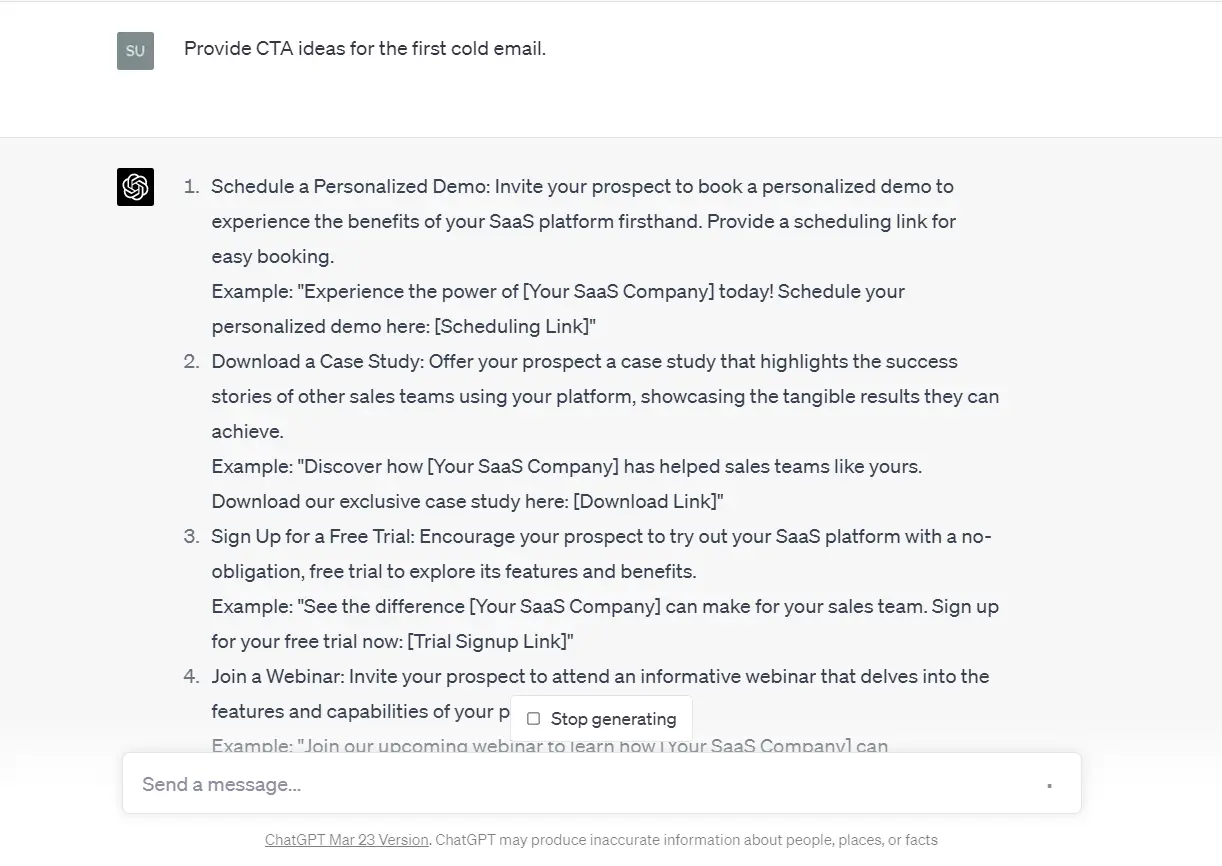
It is up to you to use the ideas or change them. They work as a nudge to your thought process, helping you save time.
Generate Multiple Templates
You can have templates for your emails, but writing them from scratch can be quite a task which is why we recommend that you use ChatGPT to write a few templates for you that you can use for your campaigns.
Write 4 cold email templates for a SaaS company offering a sales automation tool.
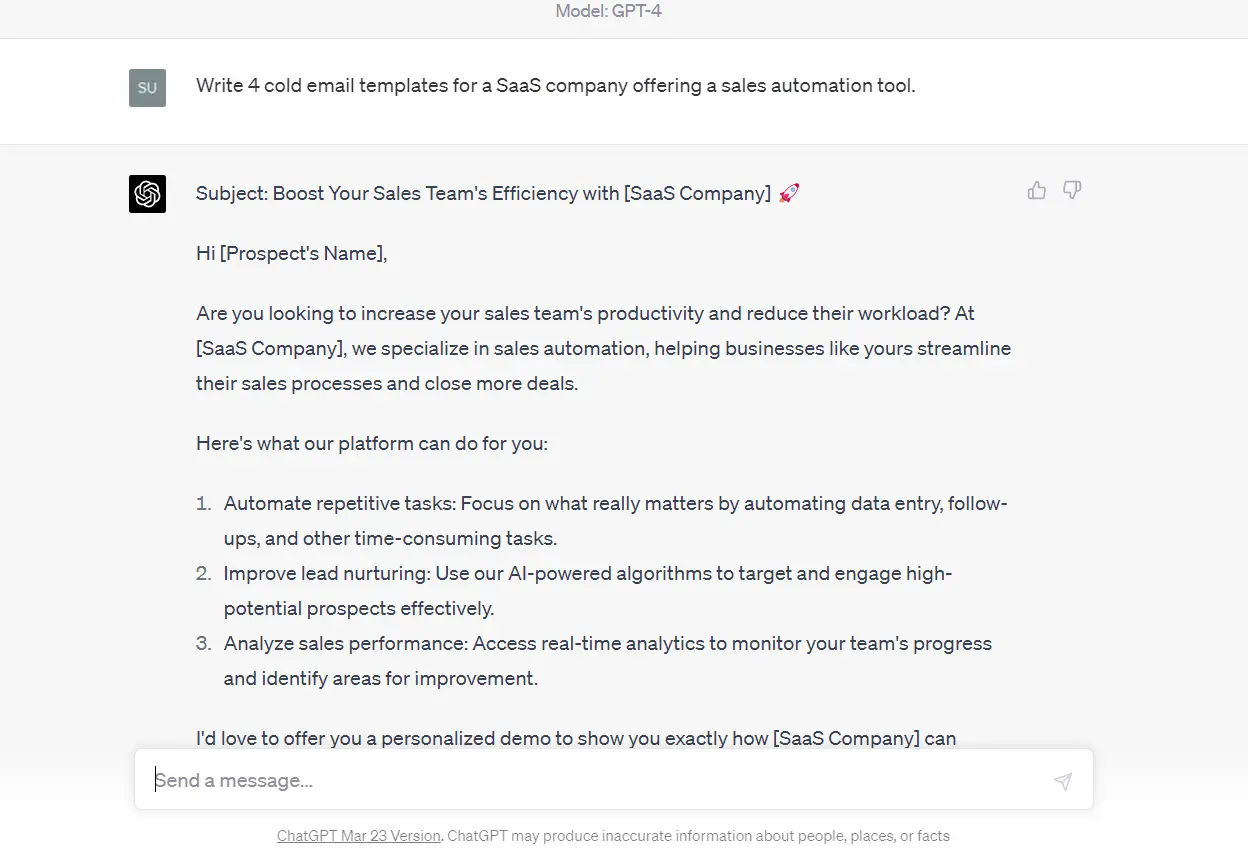
You can use the output to create effective emails.
Proofread Your Email Copy
Even though ChatGPT is terrific at generating text and provides increased productivity, it’s still super important to proofread what it comes up with. Sometimes, it might mess up grammar or even have some typos. Plus, since it’s trained on a bunch of data, it might end up with outdated or incorrect info. We’ve also got to keep an eye out for any unclear or ambiguous parts and make sure it’s got the right tone and style for what we’re going for.
But there’s more to it than just that. ChatGPT as an AI copy generator might not always get the context or nuances of a topic, so proofreading helps keep things appropriate and relevant. And we’ve got to make sure everything makes sense and flows well, right?
Oh, and one more thing – proofreading helps us catch any content that might be offensive, harmful, or just not cool. So, even though ChatGPT is a fantastic tool, double-checking its work is always good!
That’s all. You now know how to write cold emails using ChatGPT.
Here’s How ChatGPT Can Help You Write High-Performing Cold Emails In SalesBlink
By now you know that ChatGPT can be quite helpful for writing emails.
Now let me show you how you can supercharge this by combining ChatGPT with a sales outreach sequencing tool like SalesBlink.
Using ChatGPT-powered SalesBlink is the best way to write cold emails that have a high reply rate.
Now, you need not sit for hours writing a cold email.
Instead, you can generate multiple high-performing cold email copies instantly and improve them.
Here’s how SalesBlink will do it for you,
- Go to Outreach > Templates. Click on ‘Create New Template’.
- Once the template editor opens, name the template and enter the ChatGPT prompt.
Here are few examples:
- I want to sell digital marketing services
- I sell lead generation services to SaaS companies
- Write a cold email to sell my CRM SaaS
- My startup provides health insurance to businesses
- My organization deals with accounting software
- I sell sales forecasting software to enterprises
- Click on ‘Generate’ and the email copy and subject line are generated.
- SalesBlink also checks for Spam Keywords that might exist in the email body, so that you can remove them for better email deliverability.
Note: There’s no need for unsubscribe text, this email can be sent as though it is tailored for the prospect.
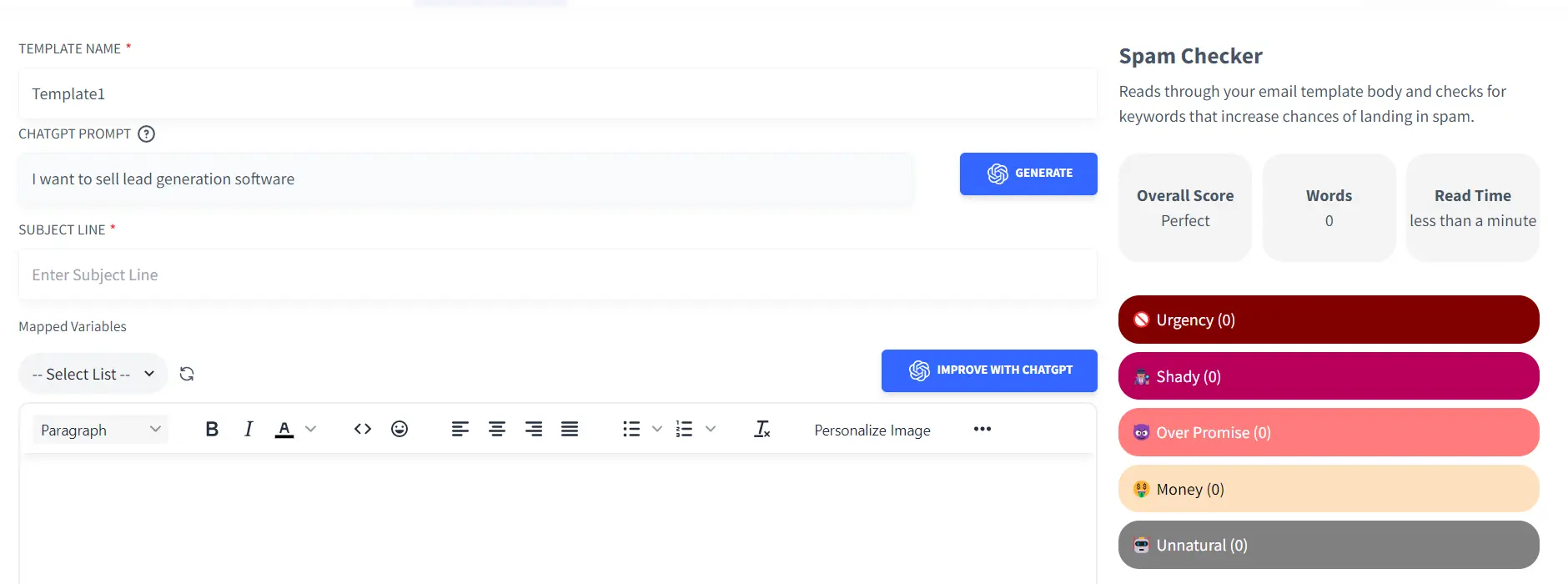
ChatGPT in SalesBlink works way better at generating high-performing cold emails and subject lines because we have trained it to work on minimal input.
Just one line is enough to generate email copies that get you more replies.
Now say no to lengthy prompts with SalesBlink!
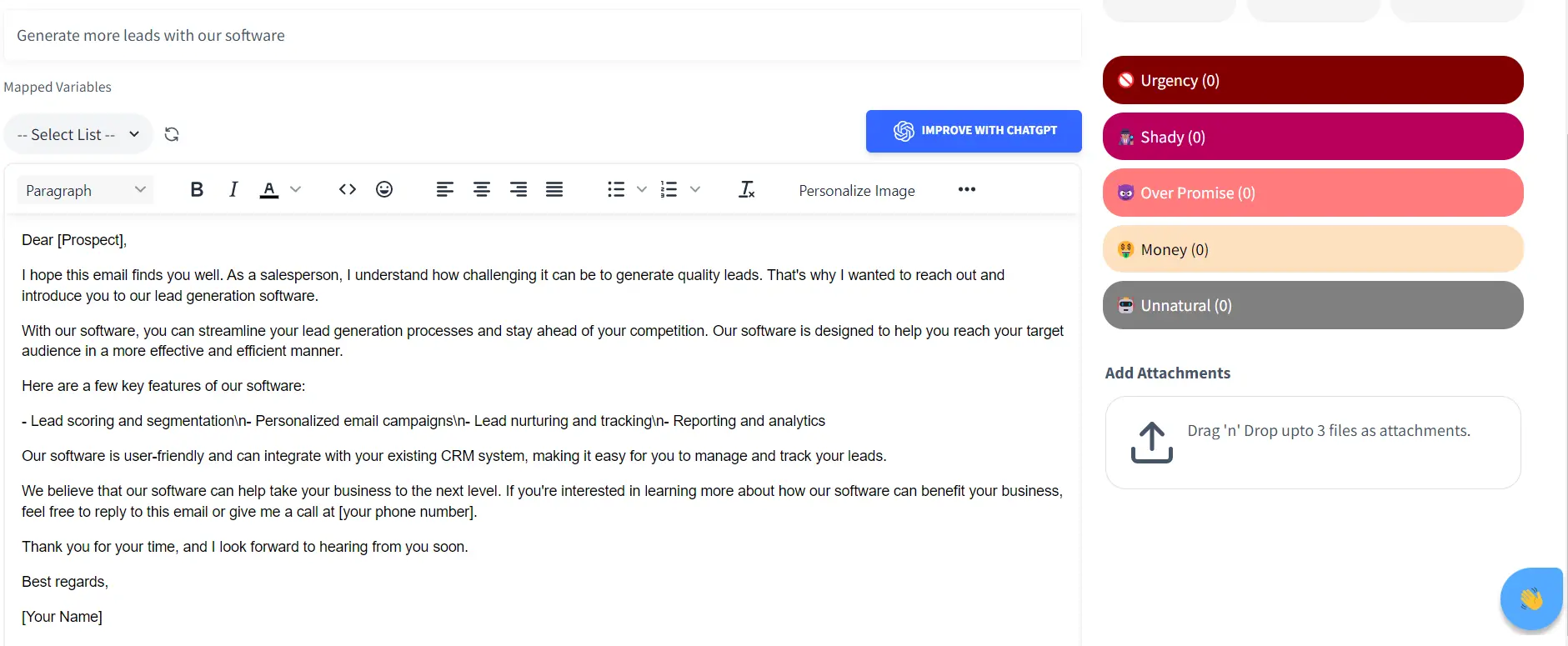
Feel free to make changes to the email based on what you plan to sell.
You can also click on ‘Improve with ChatGPT’ to improve the email according to the edits.
Additionally, you are free to personalize the email copy and subject line by adding variables such as {{first_name}}, {{company}}, and so on.
- Finally, save the template and use it for your sales outreach sequence.
So, can’t wait to write a cold email with SalesBlink?
You can also use ChatGPT-powered SalesBlink to generate email outreach sales sequence with a single line prompt. It will help you save time.
Curious to use? Give it a shot by starting a trial here.
ChatGPT Prompts to Write Cold emails & Follow Ups
Here are more prompts that you can use to write sales emails and follow-ups,
- Write a cold email to a prospect in the SaaS industry. Their pain points are the inability to generate leads and the manual process taking too long. We are offering a lead generation tool as a solution. Try to keep the email less than 100 words long.
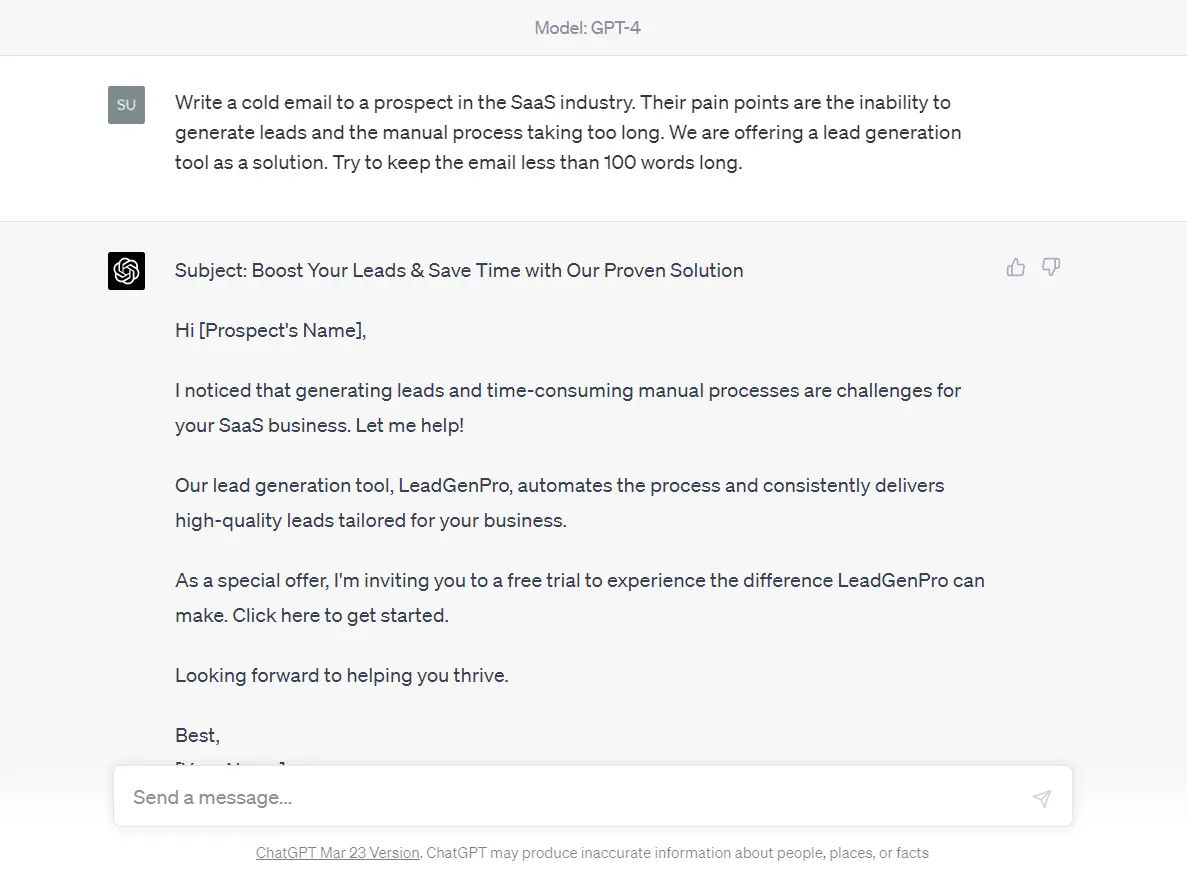
- Make the tone of the email more conversational.
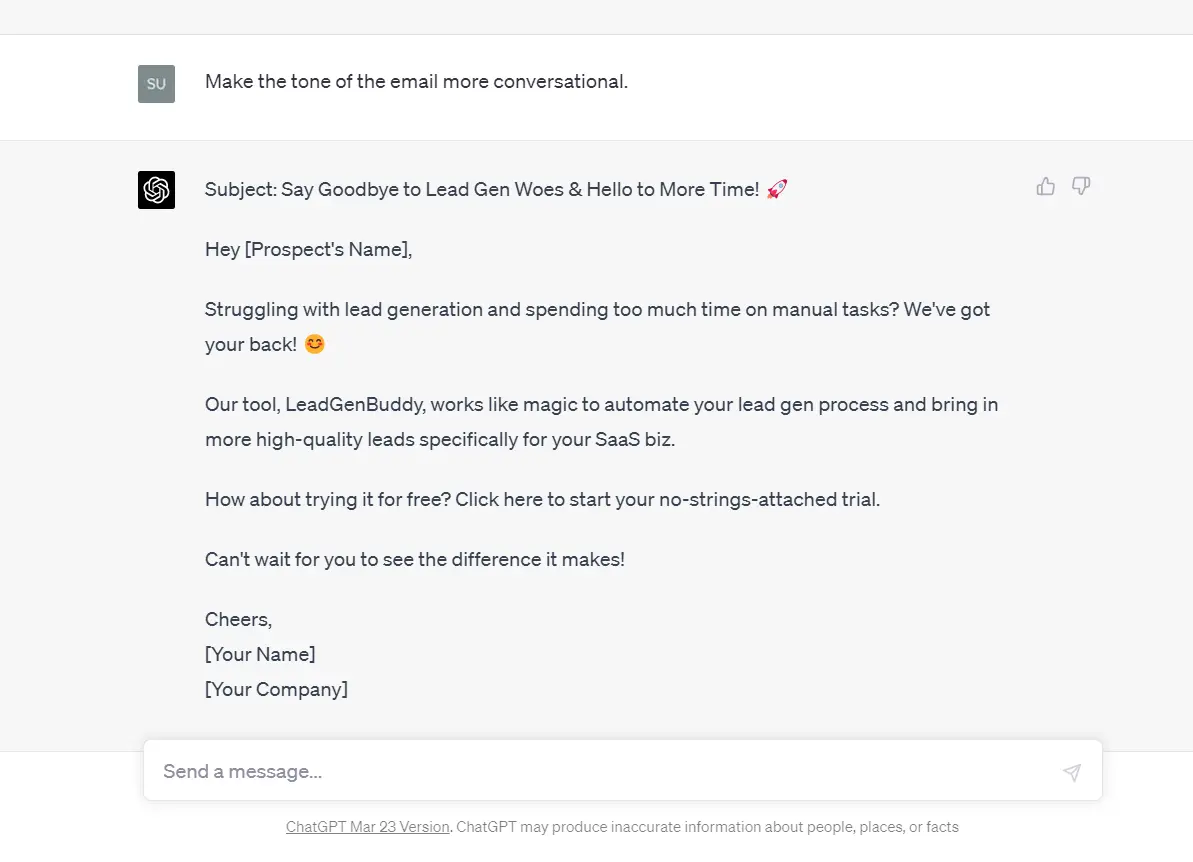
- Write subject lines for the above email that are click-worthy.
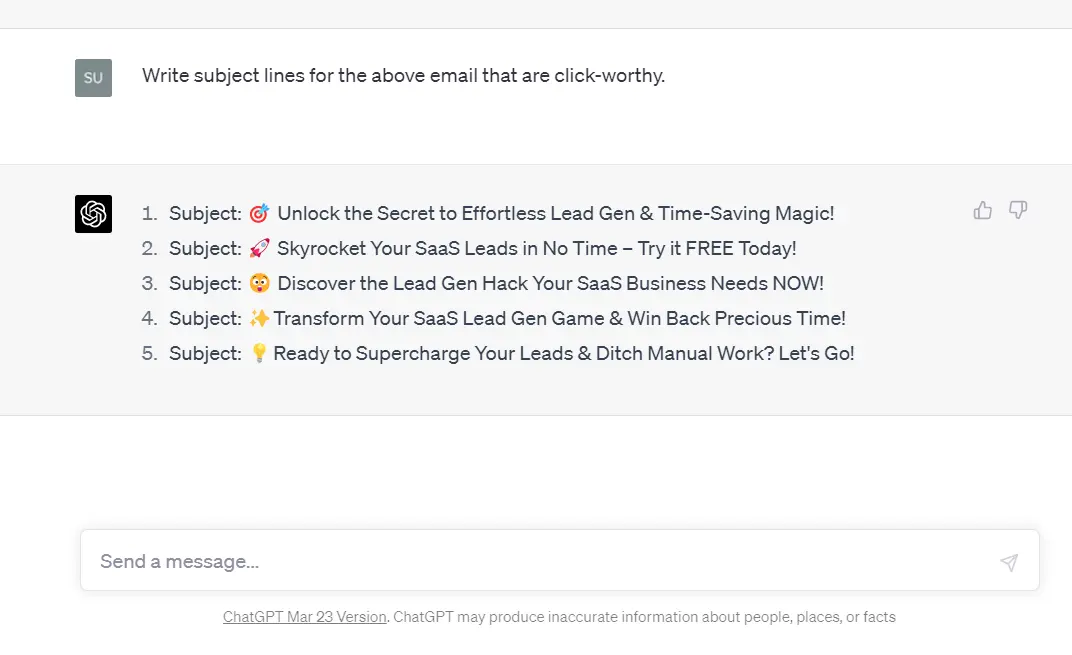
- Provide 3 follow-up emails for the previous email targeted at those who have opened the email but didn’t reply.
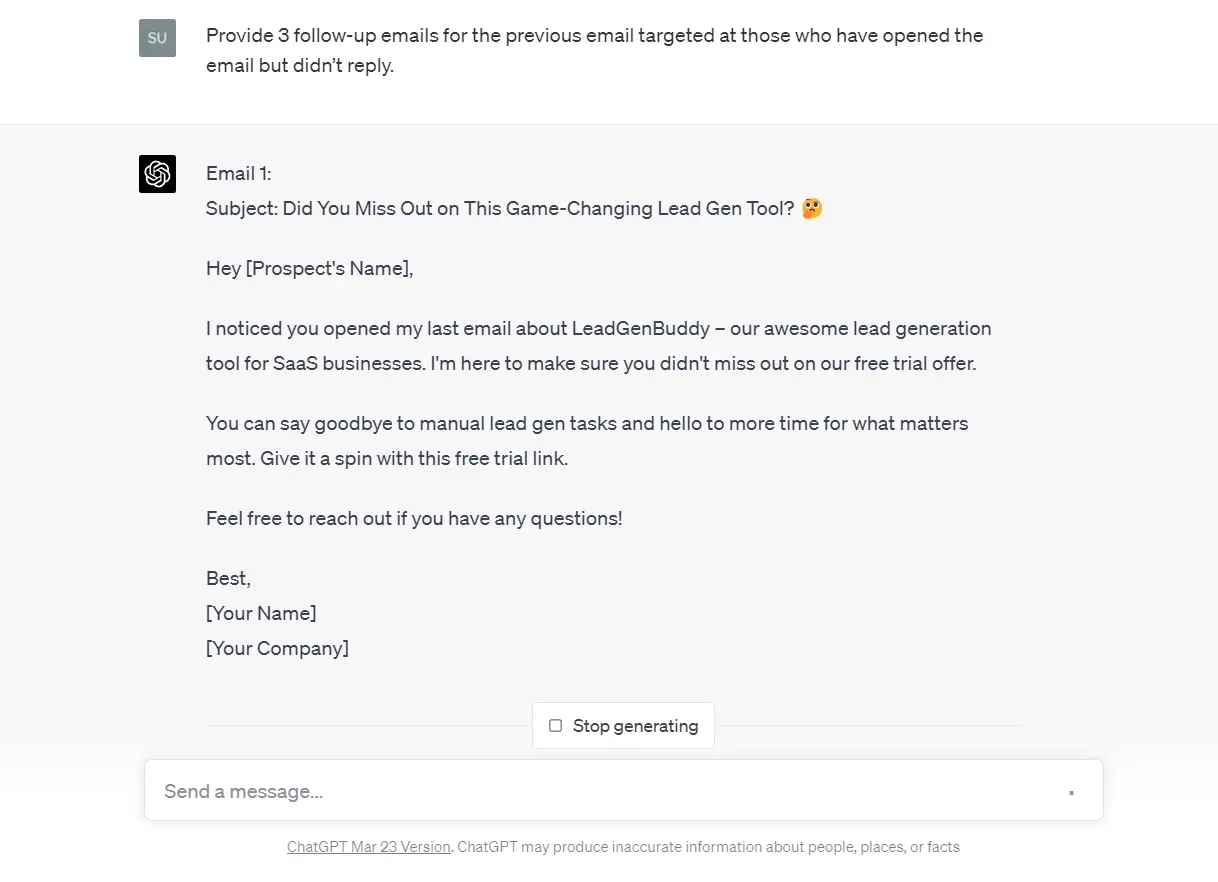
Write Cold Emails Using ChatGPT & Simplify Life!
Using an AI writing assistant to write your cold emails is an innovative and effective way to connect with potential clients, partners, or employers. By leveraging the power of AI and our 11 prompts, you can create personalized and captivating emails that leave a lasting impression on your recipients. Remember, it’s all about finding the right balance between professionalism, personalization, and persuasion.
As you explore the world of AI tools that assist cold emailing, don’t hesitate to experiment with different prompts, styles, and ideas to discover what works best for your audience. You can even use ChatGPT for Linkedin outreach.
You have to refine your approach to maximize your cold email success.
We hope this blog post has inspired you to tap into the full potential of ChatGPT as an AI writing tool and elevate your cold outreach game to new heights.
Happy cold email marketing!
FAQs
Yes, you can use ChatGPT to help draft, edit, or proofread emails. It can assist you in writing better cold emails for sales. Just describe the purpose of your email, the recipient, and any other relevant context, & ChatGPT can help generate a draft for you. However, you should always review the generated content.
You can use ChatGPT to understand the target audience’s pain points, write the first draft of your cold email, generate follow-up emails, generate follow-up emails, generate catchy email subject lines, brainstorm CTA ideas & much more.
To get ChatGPT to write cold emails that get maximum responses, you must provide the context of the email in the prompt. Be as descriptive as possible, and after you get the output, proofread it before you use the email for sales outreach.
